Good morning everyone, and welcome back to another edition of Marvel Masterpieces Parallels in Masterpiece Theater here on Hipsters of the Coast! I’m continuing my exploration of Upper Deck’s Marvel Masterpieces from 2016-2020, my deep dive into the most recent Marvel Masterpieces 2020 set by Dave Palumbo.
As I neared that series completion, I became curious about how his work would connect to the previous two “modern” Masterpiece sets that came before him. The 2016 set was done by Joe Jusko, artist of the first Marvel Masterpieces set in 1992. And in 2018, the hugely popular Italian comic artist Simone Bianchi followed in his footsteps, and completed his own Marvel Masterpieces set with new characters, new Battle Spectra scenes, and an entirely different stylistic take on the Marvel universe.
Each of the three sets are completely unique, and puts an artist’s style in the full spotlight. Jusko’s look is classic comic book, with all the muscle, color, and vibrancy of the sets from the 1990s, but reimagined with nostalgia for a new century. Bianchi is more contemporary: darker and grittier with bold blacks and colored outlines to make his characters distinct and out of this world. Palumbo falls somewhere in the middle: his big brushstrokes give a painterly feel to the genre, and bring a balance to the modern Masterpieces. His rendition especially is something that trading cards have never seen.
Across the three sets 2016-2020, there are 42 characters that were painted into each set at least once, and several characters that have multiple appearances within a given year. In total we’ll look at more than 175 artworks throughout this series from each of the last three iterations of Marvel Masterpieces. We’ll compare and contrast each artist’s creation, and learn some pretty cool stuff directly from the artist’s themselves along the way. This series isn’t about picking the best work, but rather talking about why each is a Masterpiece in its own right, and how these works function as a family of premier illustrations both within and across their respective sets.
Today we continue along what is now a four article series focused around the members of the Avengers and those who oppose them. Today will be a bit of fun, as I will highlight one of the relationships that blossomed within the Marvel Cinematic Universe, that between Thor Odinson and Bruce Banner, the Incredible Hulk. While they may seem nothing alike on the outside, by the time I finish juxtaposing their fourteen combined artworks, we’ll these two aren’t so different after all. This is Parallels: Thor & Hulk!
Thor & The Incredible Hulk: A Pre-History
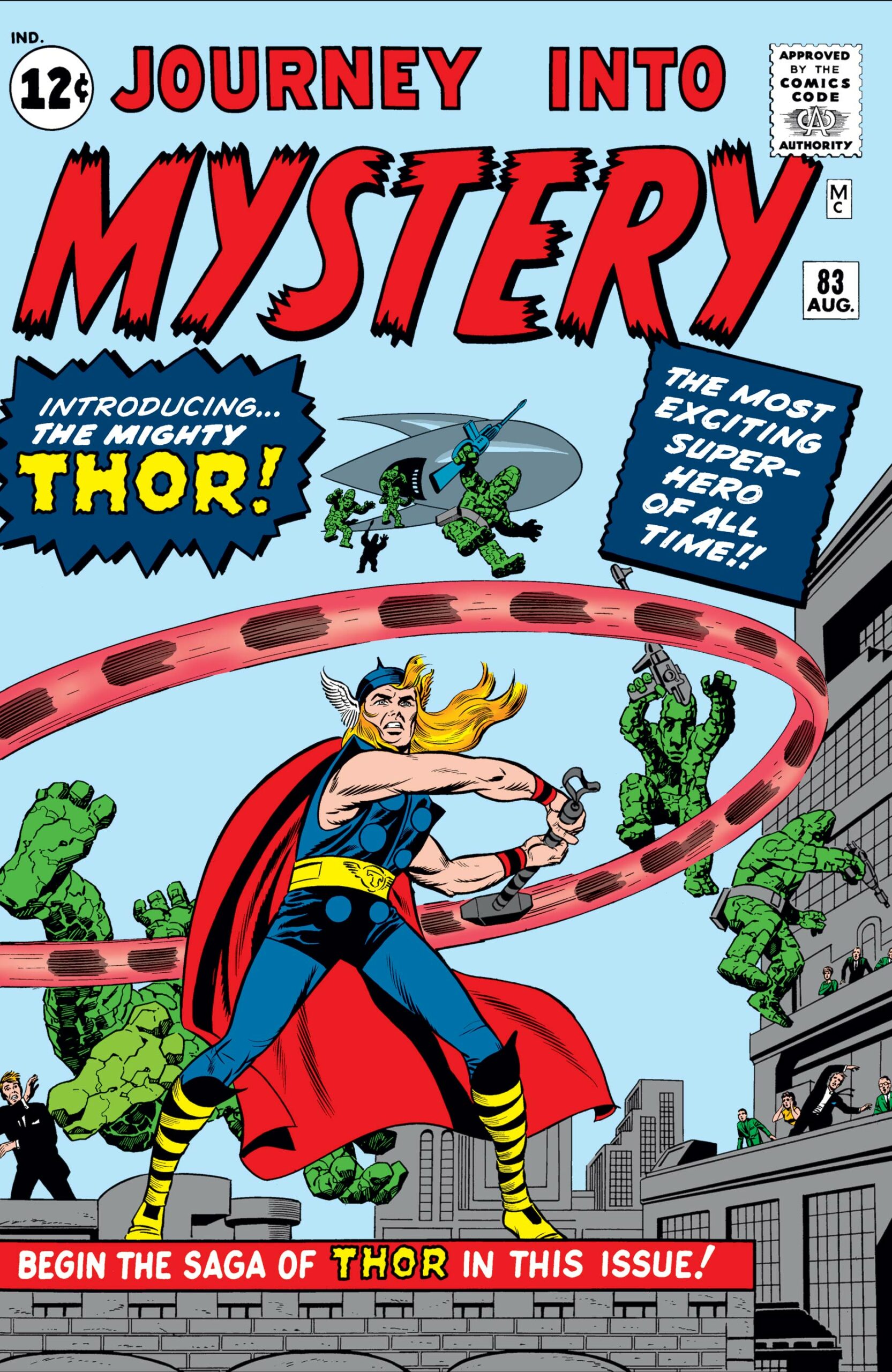
The superhero known as Thor, based on the god from Norse mythology of the same name, has been known by many monikers throughout his half century in the Marvel universe. The Mighty Thor, Thor, God of Thunder, Odinson, and in the MCU for a moment, Point Break. He first appeared in Journey Into Mystery #83 in August of 1962, when the mightiest in all of the Ten Realms was sent to Midgard, or Earth, by Odin the Allfather. The rest has been history
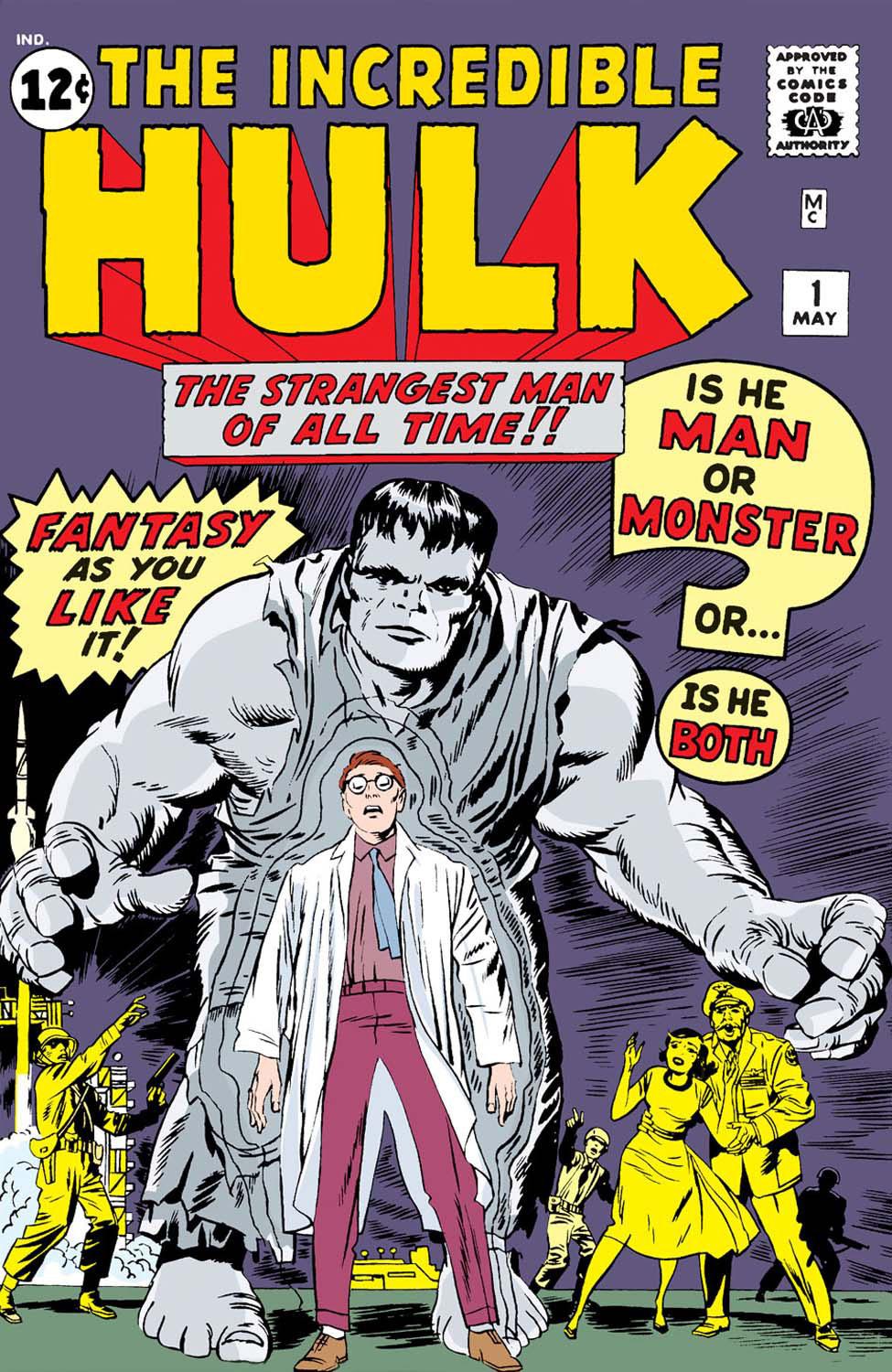
It seems fitting that Dr. Robert Bruce Banner, who we know better as the Incredible Hulk, appeared only months earlier that same year in a self titled strip The Incredible Hulk #1. Banner is a brilliant physicist, but in his development of the Gamma Bomb under General Thaddeus Ross, was bombarded with radiation and mutated into the green giant we know today. The two alter egos of Banner and Hulk have had a contentious relationship, and we see that fully realized across his trading card depictions.
In The Air
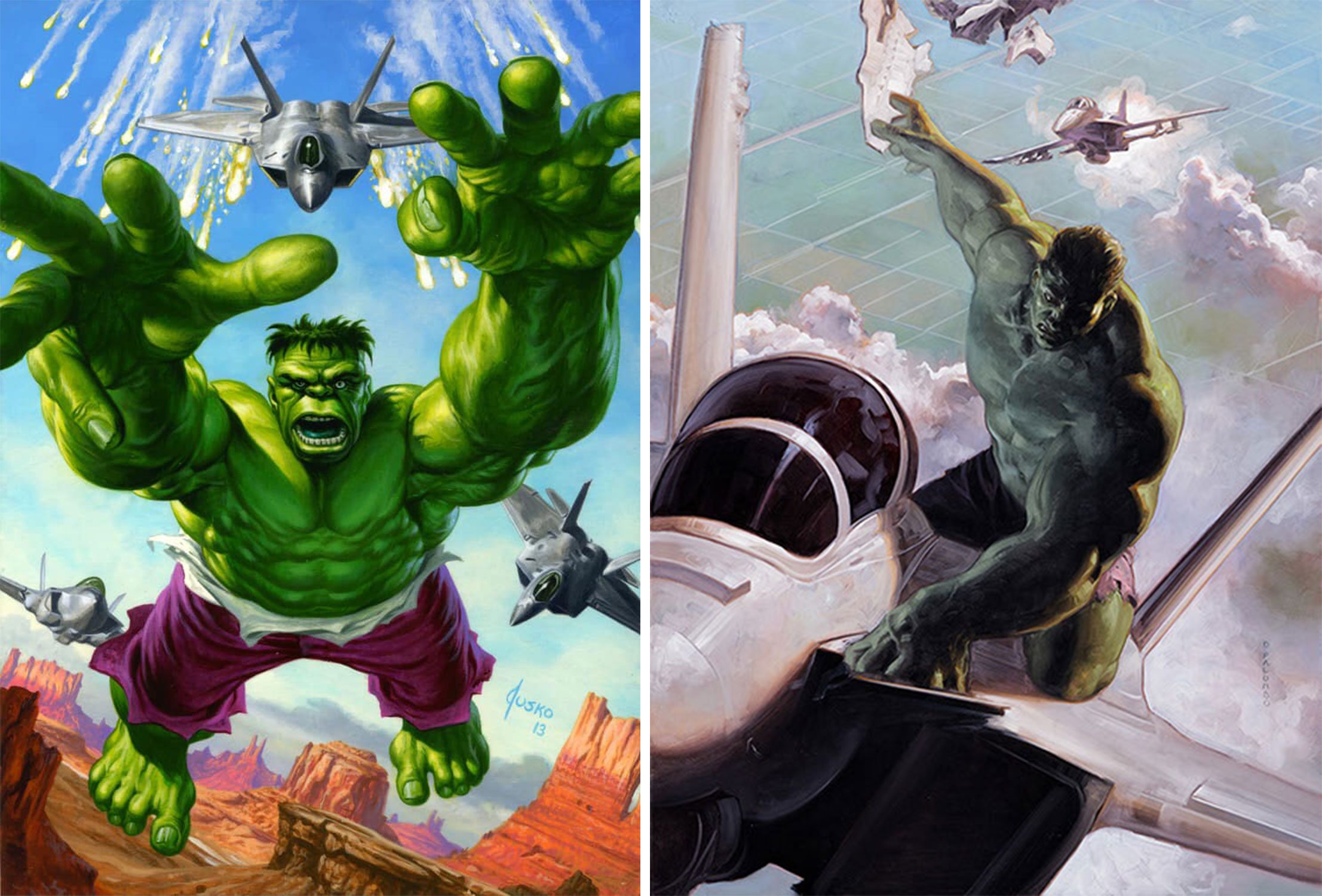
Left: Hulk (Base) by Joe Jusko, 2016. Right: Hulk (Canvas Gallery) by Dave Palumbo, 2020.
Let’s begin in the air, where we find our two heroes on four of their fourteen total appearances across the three sets. Even being superheroes not all folks can fly, and in showing them this way, it’s an extra display of power and prowess that simply isn’t equal across the genre. Hulk can’t fly so to speak, but his superhuman strength allows him to propel himself in the air, and what better to show that than literally fighting fighter jets? Both Jusko and Palumbo went this route; Palumbo’s Canvas Gallery variant shows what happens if the Hulk sticks his landing. And Jusko’s Hulk is pursued in the desert a la his Tales to Astonish appearances. Jusko even calls this his favorite painting of the entire set in his book.
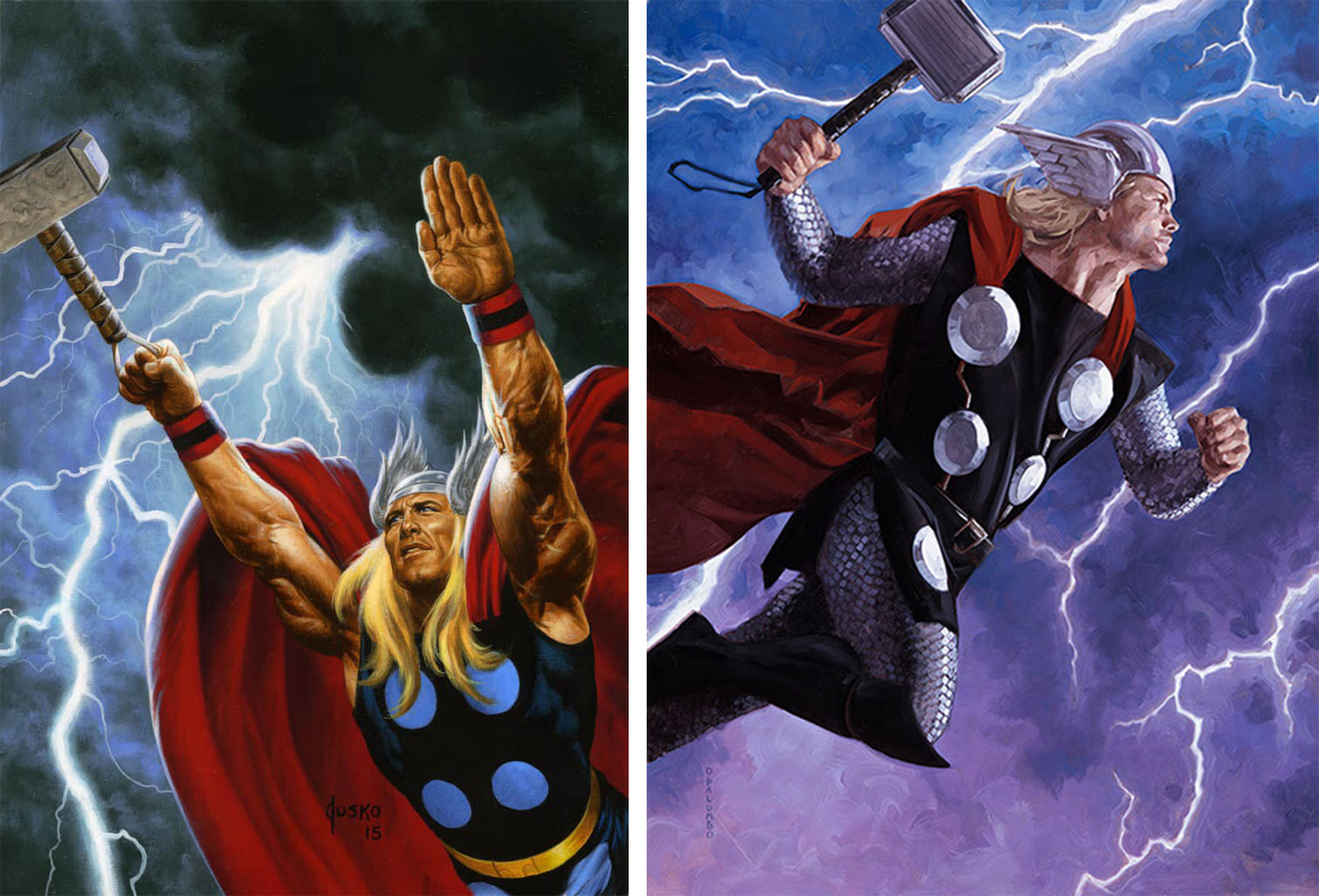
Left: Thor (Canvas Gallery) by Joe Jusko, 2016. Right: Thor (Base) by Dave Palumbo, 2020
Thor flies by way of his godly hammer Mjolnir, and these two works side by side show us a “ready for take-off” and what happens when he’s clear! Jusko captures Thor right before he leaves the ground, and Palumbo shows us the mighty avenger as he flies through a lightning storm. You might remember that each of Dave Palumbo’s works have a soundtrack too, and I encourage you to cue it up as you look at this duo.
Look Out Below
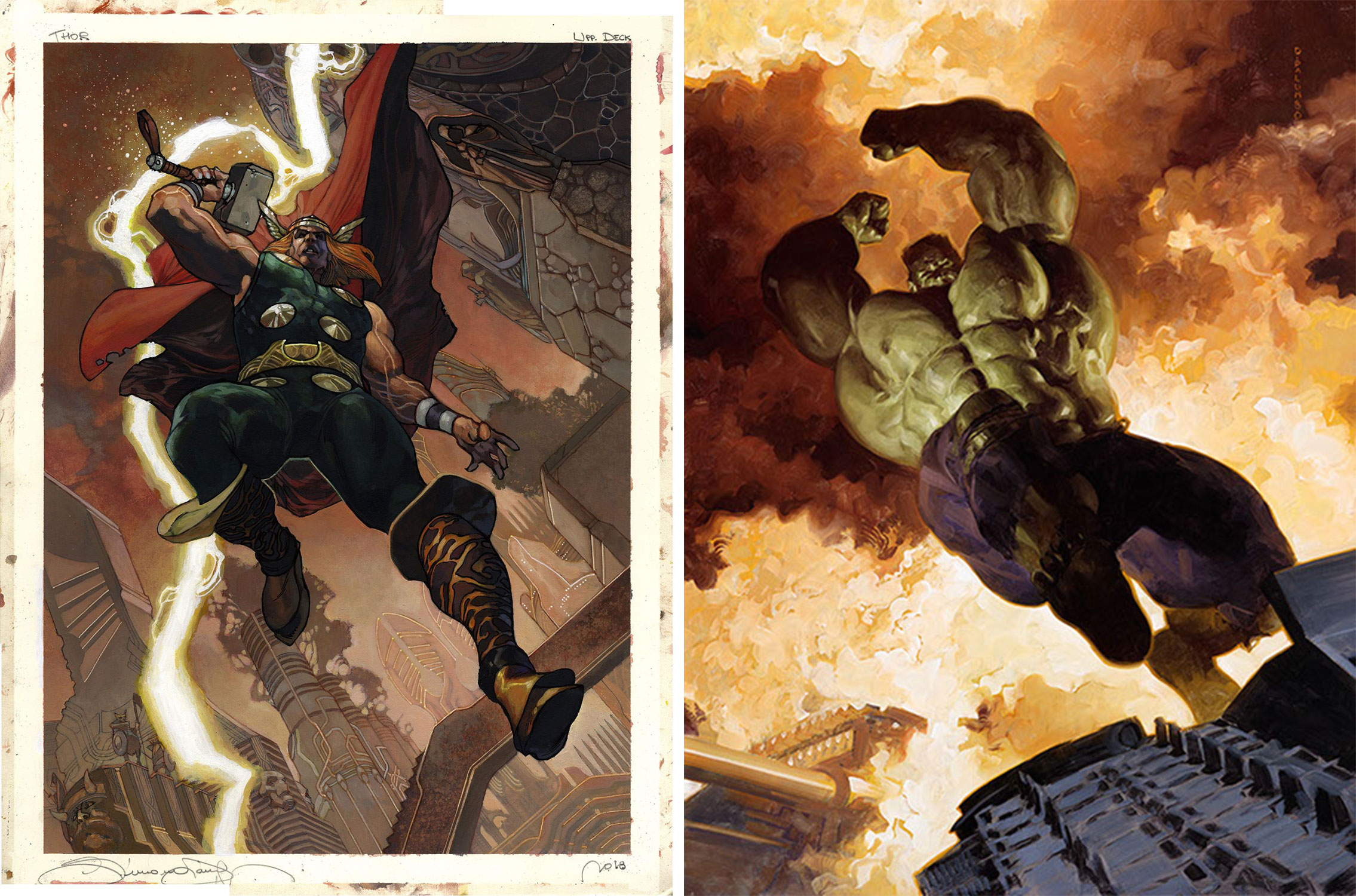
Left: Thor (Canvas Gallery) by Simone Bianchi, 2018. Right: Hulk (Base) by Dave Palumbo, 2020
What goes up must come down of course, and in each set we get a dramatic superhero landing from each of our title characters. Both Thor and Hulk are captured on their way back to earth, seen in dramatic top-down pose as we look up from the ground. Dynamic lighting, bulging muscle, and a towering cityscape background add to the depth and speed at which they’re approaching, and make these each one of my favorite perspectives for either character in the entire group.
WHACK & SMASH
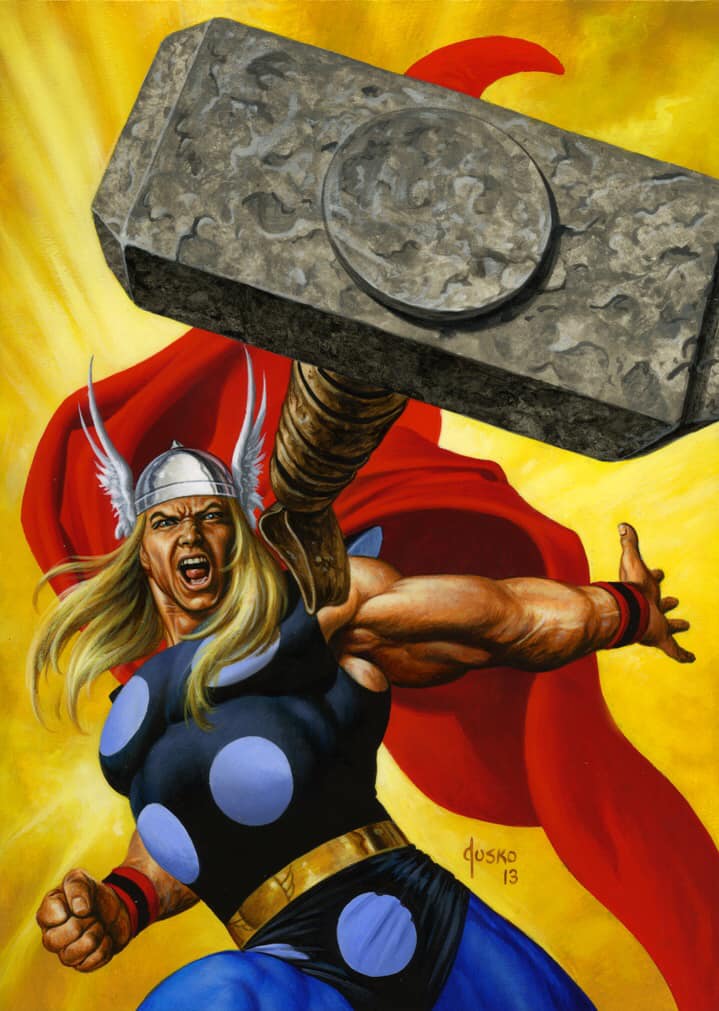
Thor (Base) by Joe Jusko, 2016
Once on the ground it’s time to take care of business, and we’d be remiss to think there wouldn’t be some action shots showing just what these two guys can do. Jusko’s Thor gives us the Son of Asgard flinging Mjolnir right at us, as it threatens to break the fourth wall and shatter the card frame.
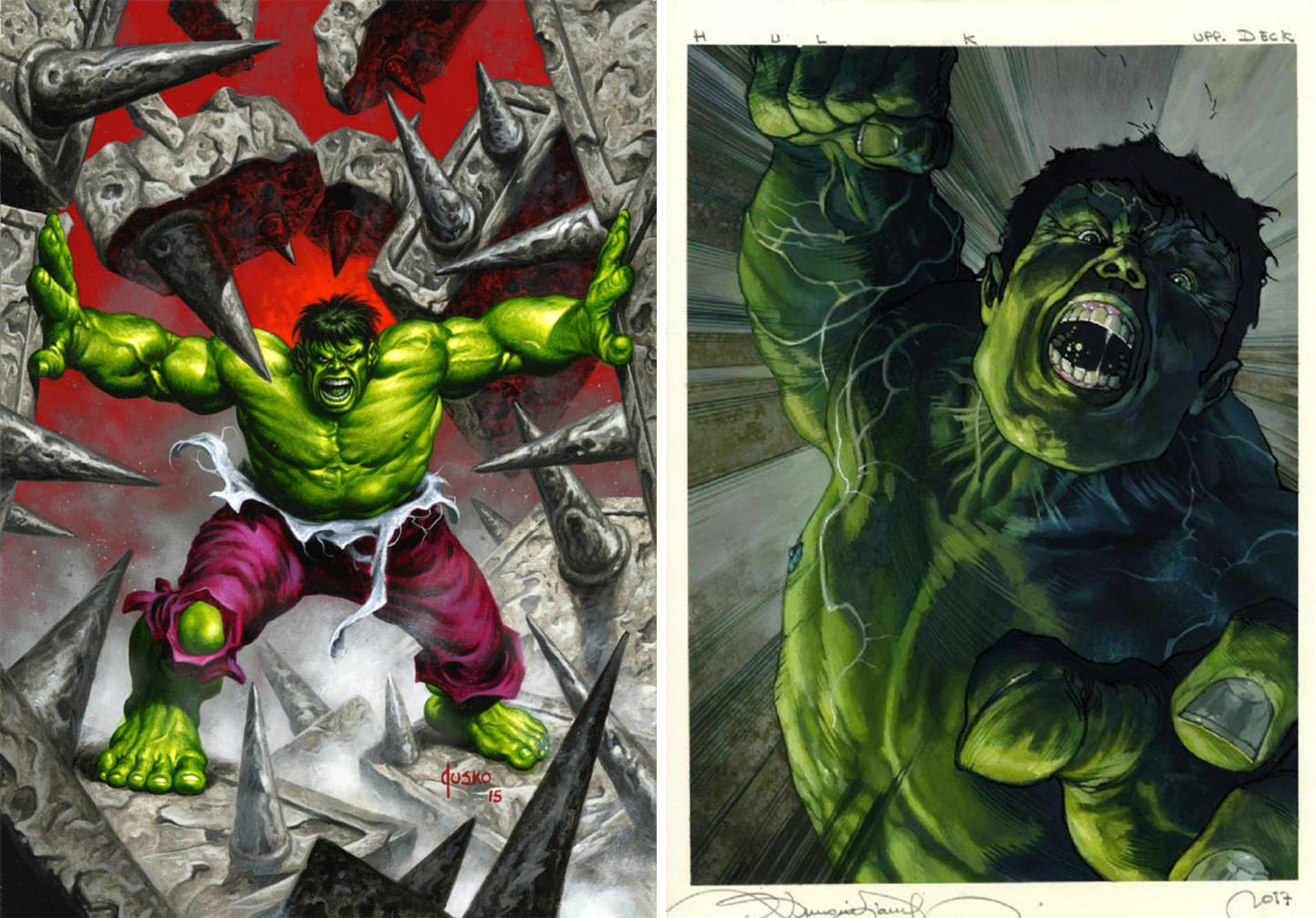
Left: Hulk (Holofoil) by Joe Jusko, 2016. Right: Hulk (Base) by Simone Bianchi, 2018
I think we’re all quite familiar with the term HULK SMASH, so it only makes sense that there are at least a few images of Hulk doing what Hulk does best. Jusko’s Holofoil variant shows the Hulk deciding to go through the wall as opposed to over or around, and Bianchi’s base is perhaps the rawest display of power in the whole set, with unimaginable fury and fervor behind that big green fist.
Flex
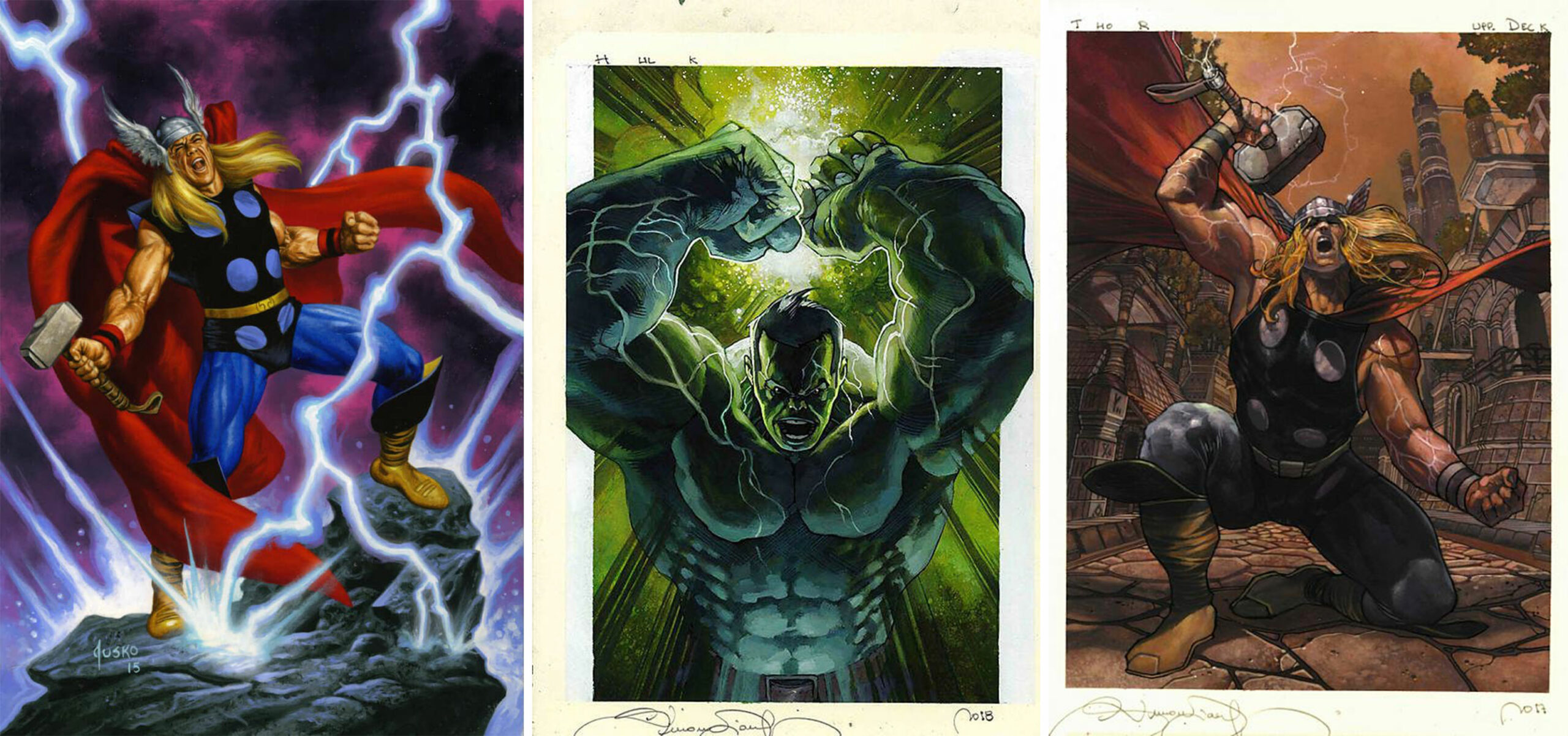
Left: Thor (Holofoil) by Joe Jusko, 2016. Center: Hulk (Canvas Gallery) by Simone Bianchi, 2018. Right: Thor (Base) by SImone Bianchi, 2018.
Our last two subsections are a bit calmer, with more superhero-ly depictions of these two. These three works deliver Thor and Hulk in full flex mode, radiant displays of their power and strength, just because they can. With Thor, we get thunder and lightning, and a raised knee as he cries out to the heavens and summons even more godly power derived from the storm. In between we get a Hulk showing off his hard work on tricep and core day, a literal wind-up to the aforementioned Hulk Smash!
Portrait Mode
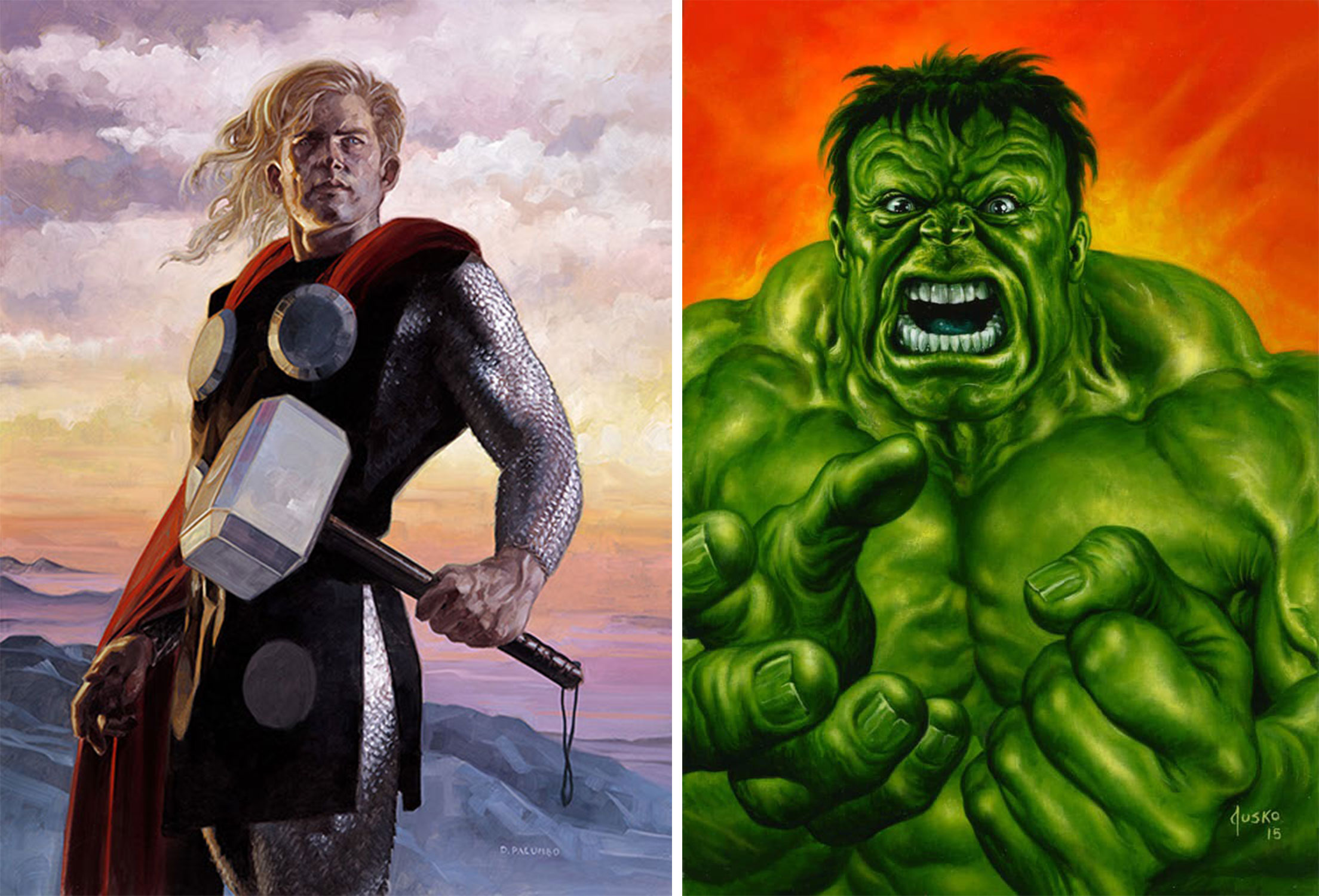
Hulk (Canvas Gallery) by Joe Jusko, 2016. Thor (Canvas Gallery) by Dave Palumbo, 2020.
I’ve been looking forward to writing this section the entire article, and as such have saved it for last. Imagine with me for a moment: Avengers Picture Day. What would the result be? Well, this is what I see.
Thor, cape and hair flowing in the wind against a beautiful backdrop, painted as a classic portrait and not a science-fiction superhero. It’s serene and beautiful, wonderfully stoic, and looks as if it belongs on a big wall of an important building. Hulk, on the other hand, appears as if you’ve just asked him to smile as best he could, and while he might be complying, is quickly running out of patience. It’s a rare piece of whimsy that also completely communicates the nature of the character; it’s a brilliant piece of work by Jusko because of it.
Wrapping Up
I had a lot of fun exploring the dichotomy of these two characters. As I mentioned at the beginning, we see that these two guys, from wildly different background and timelines, are really quite similar—not only in how they function, but how their seen by the artists responsible for telling their stories. This comparison shows how much the world of Marvel can bring common themes and ideas together, regardless of artist, time period, or subject. If a Norse God and gamma-radiated mutant can be friends and function as one, why can’t we all?
Next time in Masterpiece Theater we’ll wrap up our avengers mini-series with the villains of the team that have appeared in all three sets from 2016-2020. In the meantime, you can keep up with all things Marvel Masterpieces 2020 by following me on Twitter. Feel free to ask questions or retweet to continue the conversation. Thanks and see you next time!
Donny Caltrider has been playing Magic since 2002 and collecting original Magic art since 2017. He has an M.A. in Museum Studies from Johns Hopkins University and enjoys telling stories about art, objects, and the intersection of fantasy with real-life. You can find him on Twitter talking about #mtgart, museums, and other #vorthos related goodness. Follow along and continue the conversation!

